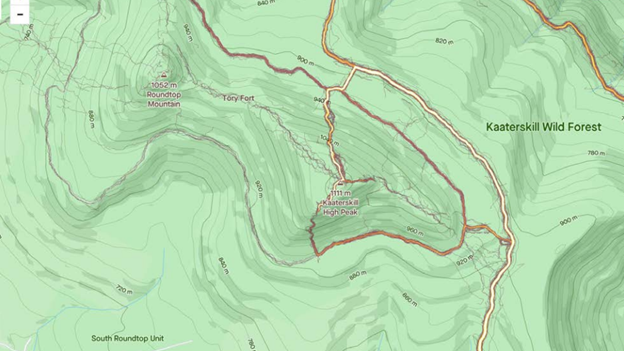Trailless No More
Trailless No More
October 14, 2022
Over the last decade, we have talked a lot about high visitor use and the challenges it presents in the Adirondack Park’s High Peaks Wilderness. But this issue isn’t limited to the Adirondacks alone. In fact, further south in the other Forest Preserve Park—the Catskill Park—high use issues have left their own mark on many of the region’s highest peaks.
For decades, these Catskill peaks were considered “trailless”, meaning that hikers had to use backcountry navigation skills to find their own route to the summit. When only a small number of hikers attempted these mountains every year, the impacts to surrounding ecosystems were relatively minor.
But over the last four years, the NYSDEC has noted a rapid expansion of informal trail networks on these peaks, so much so that they are now referred to as “formerly trailless”. Monitoring results have indicated that current levels of visitation are occurring at levels that are not sustainable and will lead to long-term damage.
When visitors create informal trail networks—either intentionally or by following previously made unofficial paths—they can impact water quality and the health of local wildlife and plant species. Over time, these informal trails harm native vegetation, compact soils, erode hillsides, fragment forests, and introduce invasive species into interior forest habitats. To avoid these outcomes, the NYSDEC is exploring management actions that would help reduce backcountry impacts.
So, what led to this sudden explosion in informal trails? We can largely attribute this to two factors: hiking challenges and GPS tracking apps.

The rise of hiking challenges, both formal and informal, have driven more and more people to visit these areas. Furthermore, some challenges even push hikers to explore mountains in unsustainable directions (e.g. too steep) or during sensitive times of year (e.g. spring mud season). These challenges continue to grow in popularity, resulting in significant alteration of the natural environment on these peaks


As herd paths in the Catskills have expanded to include sensitive ecosystems and unsustainable slopes, these new routes are being publicized by hiking gps apps, which are widely used. This exacerbates impacts, as hikers repeatedly use routes along unsustainable sections of trail and, in some cases, even across private property.
So, what can we do to help? The NYSDEC has four suggested actions:
- Avoid these areas after heavy rains or during mud season.
- Follow Leave No Trace principles
- Travel on existing informal trails and avoid dispersing into untrampled vegetation to avoid further impacting rare, threatened, and endangered plants and birds.
- From May through July, pay extra attention to where you travel and keep pets leashed to avoid disturbing vulnerable mountain bird species, many of which nest on or close to the ground and have nestlings or fledglings during these months.
- Provide comments on your expectations for the management of these areas by email to catskillpark@dec.ny.gov
For more information about the formerly trailless peaks, please watch a webinar on the NYSDEC’s website, which features presentations from DEC staff, a NY Natural Heritage Program and informal trail management expert, and a USGS federal scientist, Jeffery Marion. The NYSDEC is also inviting input to participate in a visitor use and expectation survey to gather information from the public on the preferred management solutions for the formerly trail-less peaks.
Related
ADK Applauds Updates to Adirondack Park State Land Master Plan
ADK appreciates the Adirondack Park Agency’s (APA) recent updates to the proposed final amendments to […]
Forest Preserve Advocates Applaud Final 2025–26 Budget
May 13, 2025–Albany, NY: Over forty organizations and municipalities advocating for New York’s Forest Preserves […]
Adirondack Conservation Organizations Urge Park Agency to Drop Controversial Motor-Vehicle Plan
February 17, 2025 — Ray Brook, NY — Adirondack conservation organizations today said they were […]
ADK Advocates for the EPF
February 10, 2025—Adirondack Mountain Club (ADK) staff spent the day at the Albany Capitol during […]

